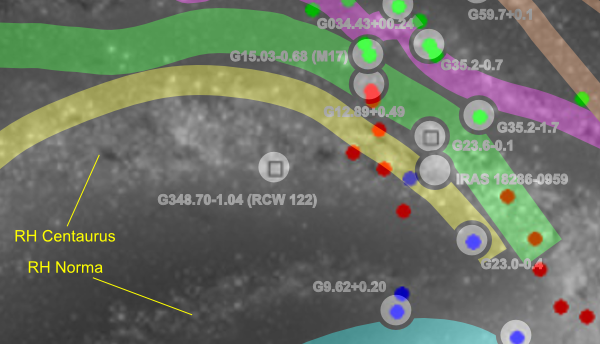Reid and Honma gave out an early Christmas present this week by submitting a paper to arXiv, Micro-Arcsecond Radio Astrometry, that includes a map of the latest BeSSeL distance estimates (see Figure 2 in the paper).
To my surprise (and a mixture of both delight and disappointment) the new estimates are largely consistent with the model of the Milky Way I released earlier this year. As a result I'll need to make minor adjustments to my model at most.
It appears that major progress on mapping the Milky Way may come from information on where major star formation regions are not located as much as where they are.
In this blog post I'll look at the new results for the near inner galaxy in the first quadrant. In my next blog post I'll look at the new results for the Perseus arm in the third quadrant.
The Reid and Honma map overlays the latest BeSSeL results on an image of the Milky Way created by Robert Hurt. The Hurt image is implicitly a model of the Milky Way that differs in significant detail from the one presented on this site. In the inner galaxy the Hurt model places the Norma and Centaurus arms much closer to the galactic centre.
I've created an image below that labels the RH (Robert Hurt) arm positions and also includes the location of the Centaurus (green), Norma (yellow) and Sagittarius (magenta) arms as well as the Orion spur (orange) and bar (cyan) from my model.
Where parallax measurements from BeSSeL or other sources were not available, I used a simple rotational model and the LAB HI velocity survey to position the arms and spurs as described here. Such kinematic distance estimates are a poor substitute for parallax-based estimates, especially given the compressed and ambiguous velocity data for the inner galaxy, which is why I was surprised to see that the latest data remains consistent with my model.

The white circles show the parallax distance estimates I used to derive my model. The coloured dots show the BeSSeL estimates. New estimates are the coloured dots not surrounded by a white circle.
Other than the previously known estimate for RCW 122, which I have analysed in detail here, all the existing and new parallax estimates line up with either structures in my model or the intense region at the near end of the galactic bar.
This is especially surprising given the large differences between my model and the Robert Hurt model in this region. Currently the data remain consistent with either model. In order to compare the model accuracy, we would need to know if there are actually star formation regions in the arm locations identified by the Hurt model. If there are no or very few star formation regions in these locations, it would provide evidence that the Hurt model may not be accurate for the near inner galaxy. On the other hand, if there are star formation regions at these locations, this would provide evidence for the accuracy of the Hurt model and suggest that my model was inaccurate in this region.
